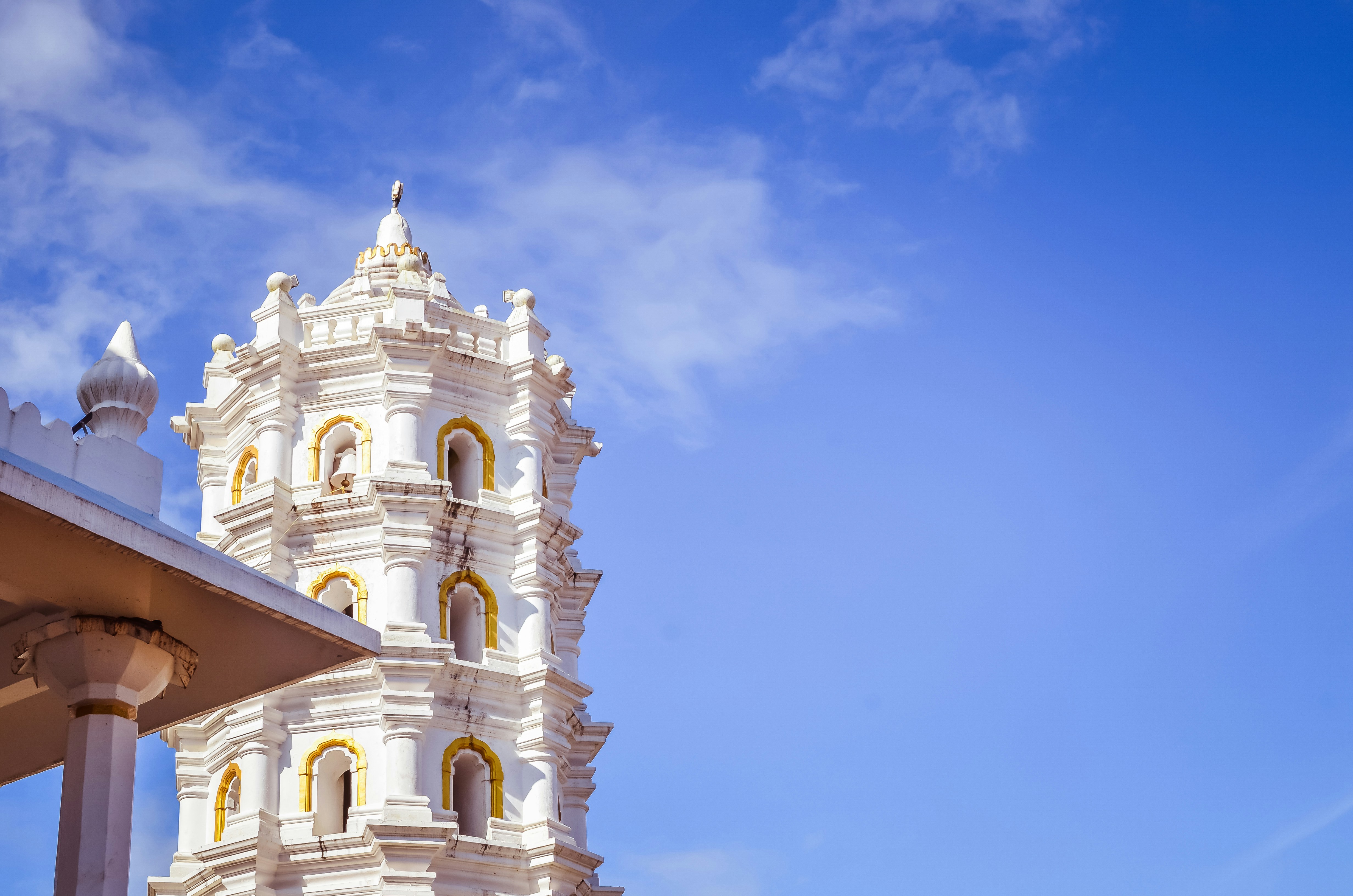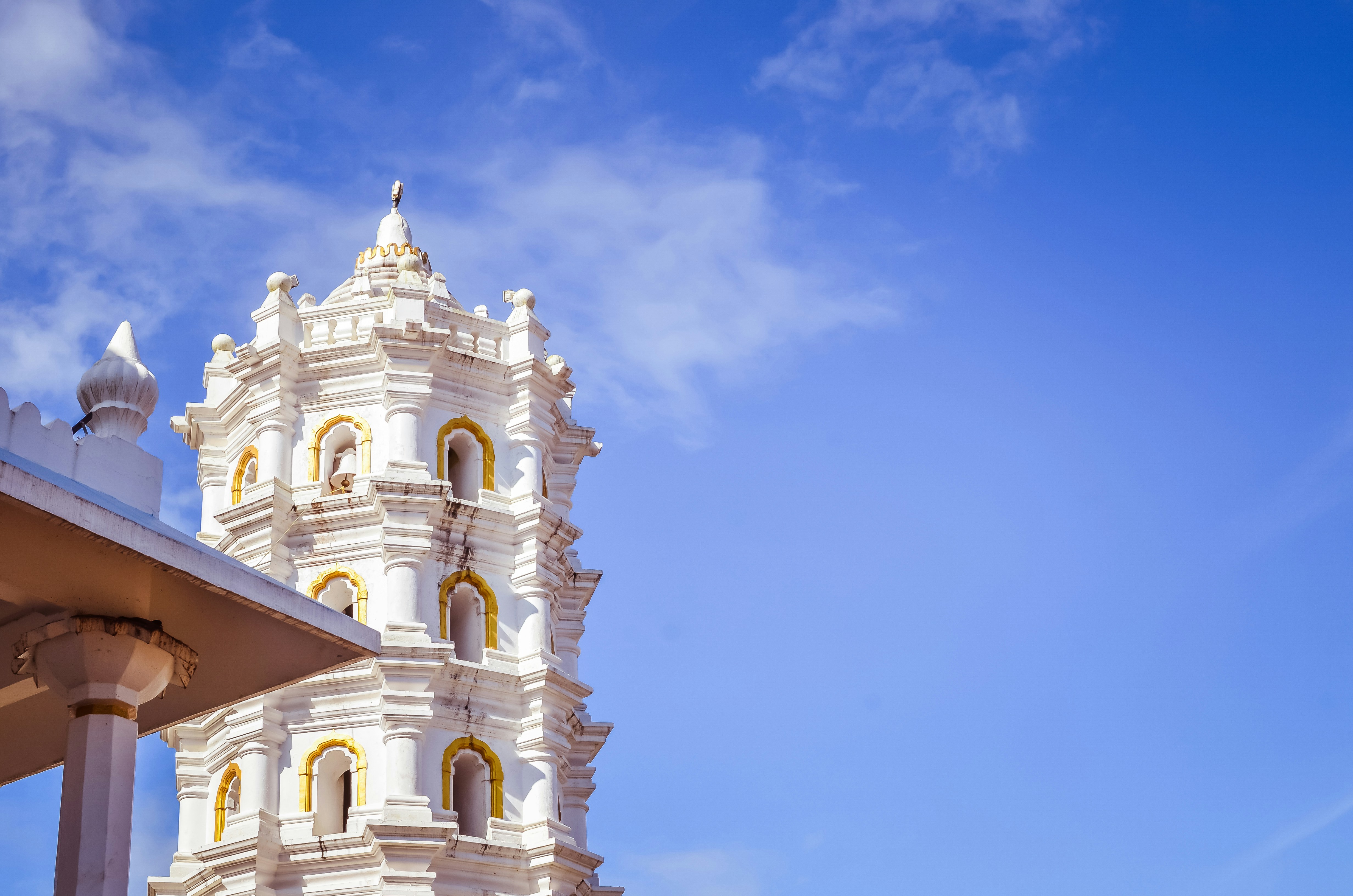The Mangueshi Temple
The Mangueshi Temple stands as a testament to Goa’s rich history and cultural heritage. Its origins can be traced back to the 17th century when it was first built by the Maratha ruler, Bhosale, in the traditional Goan style of architecture. Over the years, the temple has undergone several renovations and expansions, but it has managed to retain its original charm and spiritual aura.
Main Sanctum and Idol
As you enter the temple premises, you are greeted by a majestic gateway adorned with intricate carvings and colorful paintings. The main sanctum sanctorum, or garbhagriha, houses the idol of Lord Manguesh. The idol, made of black stone, is a sight to behold, with its serene expression and divine presence. Devotees offer prayers and seek blessings from Lord Manguesh for various reasons, including good health, prosperity, and spiritual enlightenment.
Courtyard and Pond
One of the most striking features of the Mangueshi Temple is its beautiful courtyard, surrounded by lush greenery and adorned with flowering plants. The peaceful ambiance of the courtyard provides the perfect setting for devotees to meditate and connect with their inner selves. The temple also has a sacred pond, known as the kund, where devotees can take a dip and cleanse their sins.
Religious Festivals and Cultural Events
Throughout the year, the temple hosts various religious festivals and cultural events, attracting a large number of devotees and tourists. The most significant festival celebrated at the Mangueshi Temple is the Mangueshi Zatra, held in the month of February. During this festival, the idol of Lord Manguesh is taken out in a grand procession, accompanied by traditional music and dance performances.
Spiritual Learning and Enlightenment
Aside from its religious significance, the Mangueshi Temple also serves as a center for spiritual learning and enlightenment. The temple authorities organize regular discourses and lectures on Hindu scriptures and philosophy, providing a platform for devotees to deepen their understanding of spirituality.
Architectural Beauty
Visiting the Mangueshi Temple is not just a religious experience but also an opportunity to immerse oneself in Goa’s rich cultural heritage. The temple’s tranquil surroundings, intricate architecture, and vibrant festivals make it a must-visit destination for anyone seeking a spiritual sanctuary in the midst of Goa’s bustling tourist attractions.
Relocation and Architecture
The Mangueshi Temple, with its rich history and exquisite architecture, stands as a testament to the spiritual and cultural heritage of Goa. The temple’s relocation from Cortalim to Mangueshi not only preserved its sacredness but also allowed it to flourish in a more accessible location.
The traditional Goan style of architecture is evident in every aspect of the temple’s design. The pyramid-shaped roof, or shikara, is a distinctive feature that draws the eye and captures the essence of the temple’s grandeur. The intricate carvings and sculptures adorning the shikara tell stories from Hindu mythology, adding depth and meaning to the temple’s aesthetics.
Serene Courtyard and Sanctum
Stepping into the temple complex, visitors are greeted by a serene courtyard surrounded by verdant greenery. The carefully manicured gardens and the soothing sounds of birdsong create an atmosphere of tranquility, inviting devotees and tourists alike to pause and reflect.
The main sanctum, or garbhagriha, is the heart of the temple. Here, the idol of Lord Manguesh, carved from black granite, stands as a divine presence. The belief that the idol is self-manifested adds to its significance, making it a revered symbol of devotion for worshippers.
Diversity of Shrines
Within the temple complex, several smaller shrines dedicated to various deities can be found. Each shrine showcases its own unique architectural style, reflecting the diversity and inclusivity of Hindu worship. Lord Ganesha, the remover of obstacles, is revered in his own sacred space, while Goddess Parvati, the divine mother, and Lord Nandi, the faithful steed of Lord Shiva, are also honored in separate shrines.
Spiritual Aura and Reverence
As visitors explore the temple complex, they are enveloped in an aura of spirituality and reverence. The seamless integration of history, architecture, and devotion creates an experience that is both awe-inspiring and humbling.
Religious Festivals and Community
In addition to the Mangueshi Zatra and Mahashivratri festival, the temple also celebrates other religious events throughout the year. One such event is the Navaratri festival, which is dedicated to the worship of the goddess Durga. During this nine-night celebration, devotees gather at the temple to offer prayers and perform traditional dances known as Garba and Dandiya.
Apart from the festivals, the Mangueshi Temple also plays a significant role in the religious and cultural life of the local community. It serves as a center for religious education, where young children are taught about Hindu scriptures and traditions. The temple also conducts various religious ceremonies, such as weddings and thread ceremonies, for the devotees.
Architectural Beauty and Blend of Styles
Visitors to the Mangueshi Temple are not only drawn to its religious significance but also to its architectural beauty. The temple showcases a blend of Hindu and Portuguese architectural styles, reflecting the historical and cultural influences of the region. The main entrance of the temple is adorned with intricate carvings and sculptures, depicting scenes from Hindu mythology.
Inside the temple, devotees can witness the main sanctum sanctorum, where the idol of Lord Manguesh is placed. The idol is made of black stone and is believed to be self-manifested, making it a sacred and revered object of worship. Surrounding the main sanctum are smaller shrines dedicated to various Hindu deities, creating a serene and spiritual ambiance.
Rich Religious and Cultural Heritage
Overall, the Mangueshi Temple stands as a testament to the rich religious and cultural heritage of Goa. Its religious significance, vibrant festivals, and architectural splendor continue to attract devotees and tourists alike, making it a must-visit destination for those seeking a deeper understanding of Hinduism and Goan culture.
Visiting the Mangueshi Temple
Visiting the Mangueshi Temple is not only a religious experience but also an opportunity to immerse yourself in the rich cultural heritage of Goa. The temple, dedicated to Lord Shiva, is a magnificent example of Goan architecture and attracts thousands of devotees and tourists every year.
As you enter the temple premises, you will be greeted by the soothing sound of temple bells and the fragrance of incense. The main sanctum, adorned with intricate carvings and colorful paintings, is a sight to behold. The priests, dressed in traditional attire, perform daily rituals and offer prayers to the deity.
Religious Ceremonies and Festivals
While at the temple, you can also participate in the various religious ceremonies and festivals that take place throughout the year. One such festival is the Mangueshi Zatra, a grand celebration that attracts devotees from all over Goa. During this festival, the temple is beautifully decorated, and cultural performances are held to entertain the visitors.
Nearby Attractions
After seeking blessings at the Mangueshi Temple, you can explore the surrounding area and visit the nearby attractions. The Shree Mahalaxmi Temple, located just a short distance away, is another popular religious site in Goa. Dedicated to the goddess Mahalaxmi, this temple is known for its stunning architecture and spiritual significance.
Another nearby attraction is the Nageshi Temple, which is dedicated to Lord Shiva. This temple is believed to be one of the oldest in Goa and is known for its unique blend of Hindu and Portuguese architectural styles. The serene atmosphere and the beautiful surroundings make it a perfect place for meditation and introspection.
Authentic Goan Cuisine
After a day of exploring the temples, you can indulge in some authentic Goan cuisine at the nearby restaurants. Goa is famous for its seafood delicacies, and you can savor dishes like prawn curry, fish fry, and Goan fish curry. The flavors and spices used in Goan cuisine are sure to tantalize your taste buds.
A Must-Visit Destination
Overall, a visit to the Mangueshi Temple is a must for anyone interested in exploring the religious and cultural heritage of Goa. Whether you are a devotee seeking spiritual solace or a tourist looking for a unique cultural experience, this temple offers something for everyone. So, make sure to include it in your itinerary when planning a trip to Goa.
Enter your email to get the Latest Updated Exploring News and Topics
Discover more from atozexplore.com
Subscribe to get the latest posts sent to your email.







